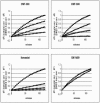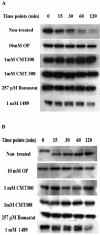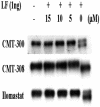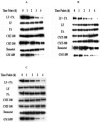Metalloproteinase inhibitors, nonantimicrobial chemically modified tetracyclines, and ilomastat block Bacillus anthracis lethal factor activity in viable cells
- PMID: 16239558
- PMCID: PMC1273843
- DOI: 10.1128/IAI.73.11.7548-7557.2005
Metalloproteinase inhibitors, nonantimicrobial chemically modified tetracyclines, and ilomastat block Bacillus anthracis lethal factor activity in viable cells
Abstract
Lethal toxin, produced by the bacterium Bacillus anthracis, is a major contributor to morbidity and mortality in animals and humans who have contracted anthrax. One component of this toxin, lethal factor (LF), proteolytically inactivates members of the mitogen-activated protein kinase kinase (MAPKK or MEK) family. In this study we show that CMT-300, CMT-308, and Ilomastat, agents initially characterized as matrix metalloproteinase inhibitors which are in early stages of development as pharmaceuticals, effectively inhibit the zinc metalloproteinase activity of LF. All three inhibitors, CMT-300, CMT-308, and Ilomastat, inhibit LF-mediated cleavage of a synthetic peptide substrate based on the N-terminal domain of MEKs. Inhibition of LF-mediated MEK proteolysis by all three agents was also achieved using lysates of the human monocytoid line MonoMac 6 as sources of MAPKKs and visualization of the extent of cleavage after separation by sodium dodecyl sulfate-polyacrylamide gel electrophoresis followed by detection by Western blotting. Finally, we have demonstrated inhibition of intracellular MEKs in viable human monocytes and MonoMac 6 cells by these agents after incubation of the cells with a reconstituted preparation of recombinant lethal toxin. All three agents are effective inhibitors when incubated with LF prior to exposure to cells, while the CMTs, but not Ilomastat, are also effective when added after LF has already entered the viable cell targets. These results offer promise for strategies to combat effects of the lethal toxin of B. anthracis.
Figures






Similar articles
-
Inhibition of the proteolytic activity of anthrax lethal factor by aminoglycosides.J Am Chem Soc. 2004 Apr 21;126(15):4774-5. doi: 10.1021/ja0495359. J Am Chem Soc. 2004. PMID: 15080670
-
The anthrax lethal factor and its MAPK kinase-specific metalloprotease activity.Mol Aspects Med. 2009 Dec;30(6):431-8. doi: 10.1016/j.mam.2009.07.006. Epub 2009 Aug 7. Mol Aspects Med. 2009. PMID: 19665472 Review.
-
The metalloproteolytic activity of the anthrax lethal factor is substrate-inhibited.J Biol Chem. 2003 Oct 10;278(41):40075-8. doi: 10.1074/jbc.M306466200. Epub 2003 Jul 29. J Biol Chem. 2003. PMID: 12888555
-
Anthrax lethal factor proteolysis and inactivation of MAPK kinase.J Biol Chem. 2003 Mar 14;278(11):9402-6. doi: 10.1074/jbc.M211262200. Epub 2003 Jan 9. J Biol Chem. 2003. PMID: 12522135
-
Exceptionally Selective Substrate Targeting by the Metalloprotease Anthrax Lethal Factor.Adv Exp Med Biol. 2019;1111:189-203. doi: 10.1007/5584_2018_273. Adv Exp Med Biol. 2019. PMID: 30267305 Review.
Cited by
-
Matrix Metalloproteinases and Arterial Hypertension: Role of Oxidative Stress and Nitric Oxide in Vascular Functional and Structural Alterations.Biomolecules. 2021 Apr 16;11(4):585. doi: 10.3390/biom11040585. Biomolecules. 2021. PMID: 33923477 Free PMC article. Review.
-
Metalloproteinases and Their Inhibitors: Potential for the Development of New Therapeutics.Cells. 2020 May 25;9(5):1313. doi: 10.3390/cells9051313. Cells. 2020. PMID: 32466129 Free PMC article. Review.
-
Ilomastat, a synthetic inhibitor of MMPs, prevents lung injury induced by γ-ray irradiation in mice.Oncotarget. 2017 Jun 15;8(37):60789-60808. doi: 10.18632/oncotarget.18487. eCollection 2017 Sep 22. Oncotarget. 2017. PMID: 28977826 Free PMC article.
-
Structure-activity relationship studies of a novel series of anthrax lethal factor inhibitors.Bioorg Med Chem. 2009 May 1;17(9):3352-68. doi: 10.1016/j.bmc.2009.03.040. Epub 2009 Mar 26. Bioorg Med Chem. 2009. PMID: 19359184 Free PMC article.
-
Development of a comprehensive, validated pharmacophore hypothesis for anthrax toxin lethal factor (LF) inhibitors using genetic algorithms, Pareto scoring, and structural biology.J Chem Inf Model. 2012 Jul 23;52(7):1886-97. doi: 10.1021/ci300121p. Epub 2012 Jun 25. J Chem Inf Model. 2012. PMID: 22697455 Free PMC article.
References
-
- Barletta, J. P., G. Angella, K. C. Balch, H. G. Dimova, G. A. Stern, M. T. Moser, G. B. van Setten, and G. S. Schultz. 1996. Inhibition of pseudomonal ulceration in rabbit corneas by a synthetic matrix metalloproteinase inhibitor. Investig. Ophthalmol. Vis. Sci. 37:20-28. - PubMed
-
- Bradley, K. A., J. Mogridge, M. Mourez, R. J. Collier, and J. A. T. Young. 2001. Identification of the cellular receptor for anthrax toxin. Nature 414:225-229. - PubMed
-
- Bradley, K. A., J. Mogridge, G. Jonah, A. Rainey, S. Batty, and J. A. Young. 2003. Binding of anthrax toxin to its receptor is similar to alpha integrin-ligand interactions. J. Biol. Chem. 278:49342-49347. - PubMed
-
- Brossier, F., and M. Mock. 2001. Toxins of Bacillus anthracis. Toxicon 39:1747-1755. - PubMed
-
- Carney, D. E., C. J. Lutz, A. L. Picone, L. A. Gatto, G. Bailey, M. Fillinger, and G. F. Neiman. 1999. Matrix metalloproteinase inhibitor prevents acute lung injury after cardiopulmonary bypass. Circulation 100:400-406. - PubMed
Publication types
MeSH terms
Substances
Grants and funding
LinkOut - more resources
Full Text Sources
Other Literature Sources

